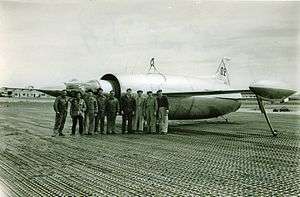Leduc 0.21
| 0.21 | |
|---|---|
 | |
| Leduc 0.20 | |
| Role | Research aircraft |
| National origin | France |
| Manufacturer | Breguet |
| Designer | René Leduc |
| First flight | 7 August 1953 |
| Number built | 2 |
The Leduc 0.21 was a research aircraft built in France in 1953 to refine the practicalities of ramjet propulsion. Initially proposed as the 0.20, it was essentially similar to its predecessor, the Leduc 0.10, but scaled up by around 30%, with tip tanks added to the wings. Again, it was not capable of take-off under its own power, and had to be carried aloft and released.
Two examples were built and completed a very detailed flight test program from 1953 to 1956 to develop automated, operationally viable throttle controls for the ramjet. This included a total of 284 free flights. Designed for subsonic speeds only, the 0.21 reached a top speed of Mach 0.95.
Specifications
General characteristics
- Crew: One
- Length: 12.50 m (41 ft 0 in)
- Wingspan: 11.60 m (38 ft 1 in)
- Wing area: 22.0 m2 (237 ft2)
- Empty weight: 3,300 kg (7,260 lb)
- Gross weight: 6,000 kg (13,200 lb)
- Powerplant: 1 × Leduc ramjet, 63.7 kN (14,300 lbf) thrust
Performance
- Maximum speed: 900 km/h (560 mph)
References
- Taylor, Michael J. H. (1989). Jane's Encyclopedia of Aviation. London: Studio Editions. p. 570.
- World Aircraft Information Files. London: Bright Star Publishing. pp. File 900 Sheet 5.
External links
| Wikimedia Commons has media related to Leduc 020. |
This article is issued from
Wikipedia.
The text is licensed under Creative Commons - Attribution - Sharealike.
Additional terms may apply for the media files.